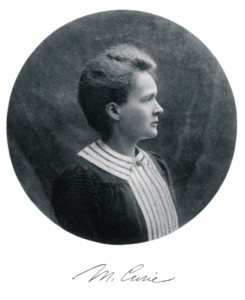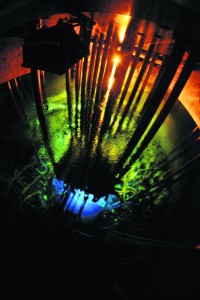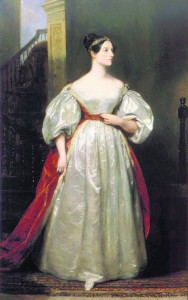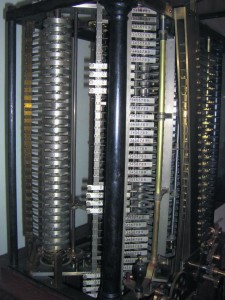SATURDAY, 7 MAY 2011
This year marks 100 years since Marie Curie was awarded the second of her two Nobel Prizes, an accolade which places her in a very select group of only four individuals in the entire history of the Nobel Prize. This centenary provides an ideal opportunity to reflect upon the achievements of some of the earliest pioneering female scientists. These women made significant contributions to vital areas of modern science, including astronomy, computing and medicine despite the barriers held against them at the time.Up until recent times, academia was a ‘man’s world’. Cambridge only awarded its first degrees to women in 1921 and did not allow women to be full university members until 1947. However there were many individuals who pursued life-long careers in the sciences during the previous two centuries.
The field of astronomy provided one of the first opportunities for women to become scientists. This was because the work always required two people; one person to operate the telescope, and one to record the findings. In this way, some women found themselves assisting their father, brother or husband in his research. Some assistants turned out to be more talented than their male counterparts, making significant findings themselves.
Caroline Herschel (1750-1848) was one of these talented assistants. Thought to be unlikely to marry due to her stunted growth, she was put at her brother’s disposal. She went on to discover eight comets, including the catchily named 35P/Herschel-Rigollet, and perfected complicated equations on spherical trigonometry which allowed the position of stars to be calculated. She even received a small salary from King George III for her work, making her the first paid female scientist. Interestingly, it was said that Herschel never learnt her multiplication tables, and always had to carry them with her on a piece of paper, despite her marvellously analytical mind. Who says you need to know your 12 times tables?
Women made developments on modern calculations and computation methods as early as 1843, as shown by Augusta Ada King. She was the only legitimate child of the poet Lord Byron, the Countess of Lovelace, and possibly the first ever computer programmer. As a skilled mathematician, she was a good friend of Cambridge professor Charles Babbage, the ‘father of the computer’. Babbage invented, but failed to build, many steam-driven, mechanical calculating machines. Among these was the Analytical Engine, which he envisaged producing long logarithms. King was asked to translate a French article about the Analytical Engine into English, and Babbage suggested she write her own notes on the subject. These notes turned out to be three times as long as the original article, and included an algorithm devised by King to be used on the machine, which is in essence the first computer program. Inspired by the cards with punched holes used by weavers to produce intricate patterns in cloth, King thought the same technique could be used to dictate the workings of the Analytical Engine. Indeed, the first computers of the 20th century were programmed by punched cards. It could be argued that King was more of a visionary than Babbage, who only wanted to create a machine for number crunching, whereas she foresaw other potential functionality such as creating music.
While modern computing is still dominated by men, no one is surprised any more by the sight of a female doctor. Yet the field of medicine used to be an exclusively male profession, and the first female doctors in the end of the 19th century faced many challenges—leading to the true sex of the first woman medic not actually being revealed until after her death. Much to the disbelief of many, Martha Stuart, or Dr James Barry as she was known, was said to have had a very hot temper and was incredibly flirtatious with beautiful women—perhaps out of frustration, or perhaps overcompensating in her disguise. She was an excellent doctor who was promoted to Inspector General, the highest rank possible for an army physician.
It is impossible to talk about great females in medicine without mentioning the ‘Lady of the Lamp’, Florence Nightingale. Nightingale is famous for bringing about a drastic reduction in death rates in the Crimean War hospitals, from 42% to 2%, by enforcing cleanliness and better nursing practices. Moreover, she started the first women’s college of nursing in London, and was an expert statistician. Her reports were very influential in the sanitary reforms of the late 1800s.
Moving from medicine to back to the physical sciences, 1867 takes us to the start of Marie Curie’s career. Born in Poland as Maria Sklodowska, she moved to Paris in 1867 to study for a degree in Mathematics and Physics. There she met Pierre Curie, and they were married within the year. They shared a love for science and worked together on radioactivity, a term coined by Marie herself.
For her doctoral studies, Marie Curie worked on the uranium-rich ore, pitchblende, which she discovered to be more radioactive than pure uranium. Reasoning that new radioactive elements must be present in the ore, she focussed on its chemical separation, while Pierre studied its radiation properties. Through this work, she discovered two new elements: polonium, named after her home country, and radium, which Pierre showed could kill cancerous cells.
It took Marie four years to purify 0.1 gram of radium from 8000 kilogram of pitchblende. She wrote, “I had to spend a whole day mixing a boiling mass with a heavy iron rod nearly as large as myself. I would be broken with fatigue by the end of the day.” Marie and Pierre both suffered from radiation burns and sickness from years of working in such close contact with radioactive materials.
The Curies’ hard work was rewarded in 1903 with a joint Nobel prize in Physics with Becquerel, after which Pierre was made Professor at the Sorbonne. Life looked quite perfect for Marie: two beautiful daughters, a loving husband and the highest acknowledgement for her contributions to science. Sadly, in 1906 Pierre was hit by a horse-drawn vehicle in the street and killed instantly. Marie was devastated but did not give up on her career; she took over Pierre’s Sorbonne chair, becoming France’s first female professor. She continued characterising her new element, radium, and was awarded her second Nobel Prize in 1911, this time in Chemistry.
The Curies’ work was critical in the development of X-rays for medical use. At the break of World War One, Marie set up a Red Cross Radiation Unit, equipped ambulances with X-ray machines and worked on the front lines, nursing injured soldiers with her daughter.
Her legacy lives on in numerous ways; be it in the many universities, the charity, or even the road in Paris named after Marie and Pierre. However, perhaps her biggest legacy is her example for women and men with scientific aspirations: with hard work and true devotion, it is possible to achieve the impossible.
Jessica Robinson is a PhD student in the Department of Oncology




